Why did it take so long for women to get the right to vote?
Sex and gender are two different concepts. Sex refers to biological differences while gender relates to the roles and expectations culture assigns to each group. Every culture struggles with adjusting the roles of men and women to secure a just and harmonious society. Several factors like religion, science, tradition and technology influence gender roles. By tradition, men had near exclusive domination of politics in the United States, but that began to change in the 19th century with increasing urbanization, educational opportunities for women and changes in home responsibilities.
Women's Suffrage in Iowa
The first Iowa constitutions restricted the right to vote to white males. Most Iowans believed that women’s natural sphere was in running the household and caring for children while men represented the family in public affairs. A women’s suffrage convention in 1848 in Seneca Falls, New York, issued a call for expanding political rights for women, including the right to vote, but the issue did not gain much visibility in Iowa until the years immediately after the Civil War. As heated debate focused on the status of freed black former slaves, some women and men began to argue that women also should be allowed to vote.
Through the 1870s and 1880s, women suffrage advocates pushed various proposals, but none could win passage in two consecutive sessions of the legislature as required to change the constitution. In public debate, the issue became entangled in the debate on the sale and manufacture of alcohol. Women were seen as allies of those wishing to prohibit or greatly limit such sales, and therefore, prohibitionists were usually advocates of granting the vote to women. When a prominent women’s suffrage leader in New York, Victoria Woodhull, spoke out for greater sexual freedom, the suffrage movement became accused of advocating for “free love.”
In 1894, the Iowa legislature granted women “partial suffrage," the right to vote on bond issues and similar matters but not where there were candidates running for office. In 1916, the state legislature submitted to Iowa voters (still all men) a constitutional amendment to remove the word “male” as a requirement to vote. Areas where pro-alcohol sentiments were strong opposed it as did liquor manufacturers. The Catholic Church, which pointed to biblical passages citing the man as head of the family, also opposed it. Counties along the Mississippi and Missouri Rivers where these two groups were strong racked up huge majorities to narrowly defeat the measure.
"Votes for Women" Around the Country
However, the issue was winning support at the national level. Iowa-raised Carrie Chapman Catt led a national women’s suffrage amendment that organized support in every state and at the national level. An amendment to the U.S. Constitution must be passed by Congress and approved by three-fourths of the states. In 1919, Congress approved a women’s suffrage amendment and submitted it to the states. In 1920, Tennessee became the 36th state to ratify it, providing the necessary three-fourths and adding women’s right to vote as the 19th amendment.
Over 75 years passed since the Seneca Falls convention first advocated giving women the right to vote. Some women like Elizabeth Cady Stanton and Susan B. Anthony spent nearly their whole adult lives working for that change. Many women who had never taken part in political activities accepted an expanded role as they joined suffrage efforts and tried to persuade lawmakers at every level of government to include them in the governing process. Today, women constitute a majority of voters but are far less than half among elected leaders. Not until 2014 did Iowa send a woman to Congress and the first woman governor was inaugurated in 2017.
Supporting Questions
What attitudes about their gender and expected role in society did women need to overcome to gain the right to vote?
- “Advice To Young Ladies” Song Sheet, Date Unknown (Document)
- “The Lid Is Off Again” Political Cartoon, March 30, 1904 (Political Cartoon)
- “Election Day!" Political Cartoon, 1909 (Political Cartoon)
- “Woman” Political Cartoon, December 5, 1914 (Political Cartoon)
- Excerpts from “Are Women People?: A Book of Rhymes for Suffrage Times," 1915 (Document)
- Anti-Suffrage Ad from The Iowa Homestead, May 25, 1916 (Document)
What tactics did suffragists use to convince society they deserved the right to vote?
- Attendees of the Iowa Equal Suffrage Convention Held in Panora, Iowa, November 9-11, 1905 (Image)
- Women’s Suffrage Parade Shown Passing by Church, October 29, 1908 (Image)
- “Jane Addams on Suffrage” Letter to the Editor in The New York Times, March 20, 1909 (Document)
- “Being Fed Through Nostrils Is Described by Alice Paul, Young American Suffragette” Newspaper Article, December 1909 (Document)
- “Votes for Women Broadside" by the Women's Political Union, January 28, 1911 (Document)
- “Votes for Women! The Woman's Reason" by the National American Woman Suffrage Association, 1912 (Document)
- "Woman Suffrage" Headquarters on Upper Euclid Ave. in Cleveland, Ohio, 1912 (Image)
- Map Abstract of June 5, 1916, Vote for Woman Suffrage Constitutional Amendment in Iowa, 1916 (Map)
- "Woman Suffrage Bonfire on Sidewalk Before White House," 1918 (Image)
What impact did the 19th Amendment have on women and their government?
- Suffragists at the 1920 Republican National Convention in Chicago, Illinois, June 8-12, 1920 (Image)
- "The Sky is Now Her Limit" Political Cartoon, August 1920 (Political Cartoon)
- 19th Amendment to the U.S. Constitution, August 26, 1920 (Document)
- Nellie Tayloe Ross, director of the Mint, at her farm on Solomon's Island, Maryland, July 29, 1938 (Image)
- H.Res. 159, "Honoring the New Hampshire State Senate for becoming the 1st statewide legislative body with a majority of women,” November 3, 2009 (Document)
| Women's Suffrage Source Set Teaching Guide |
| Printable Image and Document Guide |
“Advice To Young Ladies” Song Sheet, Date Unknown
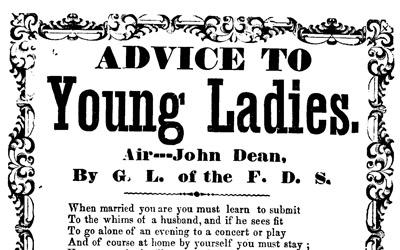
Description
“Advice to Young Ladies” is a song meant to provide advice to young women pertaining to their role and duties as an "ideal" wife. The song directs women to be submissive to their husband and "ne'er be ill-tempered, look sulky or frown." Also included on the song sheet is "…
“The Lid Is Off Again" Political Cartoon, March 30, 1904
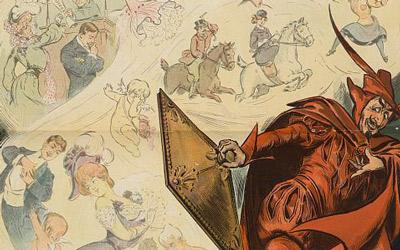
Description
“The Lid Is Off Again” is a political cartoon published in Puck Magazine on March 30, 1904. The image portrays a devil removing the lid off a box labeled "Society," allowing fumes to escape which show the dark, suggested consequences of female liberation. These negative…
“Election Day!" Political Cartoon, 1909
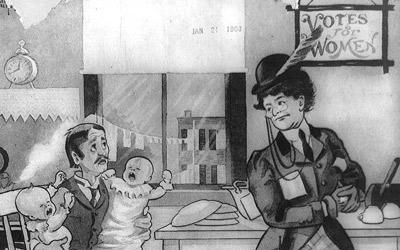
Description
“Election Day” is an image published in 1909 by E.W. Gustin. The cartoon portrays a woman leaving the house to vote on election day while her distraught husband is left behind to tend to the children and house by himself. A plate has been broken, both children are crying…
“Woman” Political Cartoon, December 5, 1914
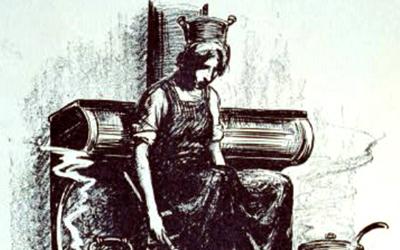
Description
“Woman” is a cartoon created by Kenneth Russell Chamberlain and published by Puck Magazine on December 5, 1914. The cartoon portrays a woman sitting slumped over on a chair atop a stove, wearing a pot for a crown, holding a broom as pots and pans are steaming around…
Excerpts from “Are Women People?: A Book of Rhymes for Suffrage Times," 1915

Description
Published in 1915, "Are Women People?: A Book of Rhymes for Suffrage Times" is a collection of poetry by Alice Duer Miller concerning suffrage and women’s rights. A large portion of it was originally published in The New York Times. Miller (1874 - 1942) was a…
Anti-Suffrage Ad from The Iowa Homestead, May 25, 1916
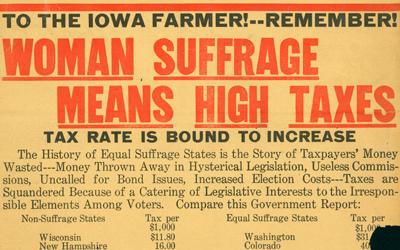
Description
This advertisement, printed in The Iowa Homestead on May 25, 1916, was funded by the Iowa Association Opposed to Woman Suffrage. The organization argues that women's suffrage would directly lead to both higher taxes and the drowning out of the rural vote…
Attendees of the Iowa Equal Suffrage Convention Held in Panora, Iowa, November 9-11, 1905
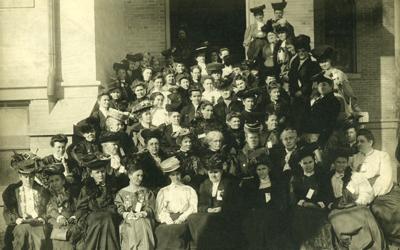
Description
This is a picture taken in November 1905 of the approximately 60 attendees, all women, of the Iowa Equal Suffrage Convention held in Panora, Iowa.
Women’s Suffrage Parade Shown Passing by Church, October 29, 1908
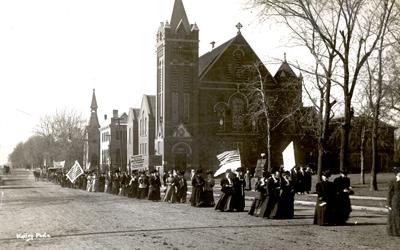
Description
In this photograph, taken in Boone, Iowa on October 29, 1908, a suffrage parade made up of people carrying banners and flags passes by a large church. One banner held by a parade marcher reads: “Taxation Without Representation Is Tyranny. As True Now As In 1776…
“Jane Addams on Suffrage” Letter to the Editor in The New York Times, March 20, 1909

Description
In responding to New York Senator Elihu Root’s anti-suffragist comments, Julia Ward Howe quotes Jane Addams in this New York Times letter to the editor. Published March 20, 1909, the op-ed explains the unsafe and unhealthy municipal conditions of keeping women…
“Being Fed Through Nostrils Is Described by Alice Paul, Young American Suffragette” Newspaper Article, December 1909
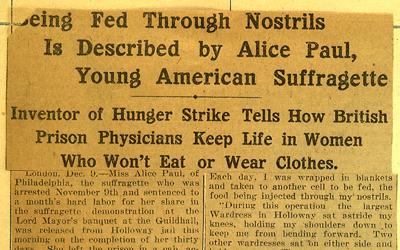
Description
Alice Paul, American women's rights activist and suffragette, describes her hunger strike and subsequent force feeding in Holloway jail in this 1909 newspaper article. Paul sentenced to seven months in jail after being arrested for…
“Votes for Women Broadside" by the Women's Political Union, January 28, 1911

Description
In this January 28, 1911, broadside published by the Women’s Political Union, a policeman is quoted as saying, “Stand back, ladies!” as ex-convicts cast their ballot while two women, one holding a baby and another dressed in an academic robe, look on. Below the image, the…
“Votes for Women! The Woman's Reason" by the National American Woman Suffrage Association, 1912
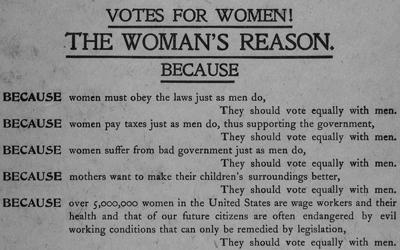
Description
The broadside, published by the National American Woman Suffrage Association, includes 10 reasons why women should vote equally with men are listed. The poster was created in 1912, and even made reference to a line made famous by Abraham Lincoln's second inaugural…
"Woman Suffrage" Headquarters on Upper Euclid Ave. in Cleveland, Ohio, 1912
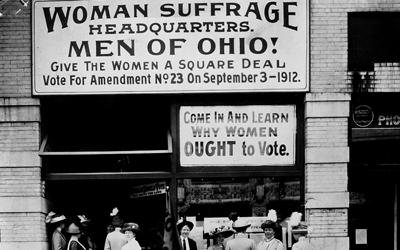
Description
This photograph was taken outside the "Woman Suffrage Headquarters" on Upper Euclid Ave. in Cleveland, Ohio, in 1912. The image shows four suffragettes in conversation outside the building, one of while is actually Belle Sherman, president of…
Map Abstract of June 5, 1916, Vote for Woman Suffrage Constitutional Amendment in Iowa, 1916

Description
This 1916 map from Carrie Chapman Catt’s scrapbook was created after the failed June 5, 1916, vote attempt to add a woman suffrage amendment to the Iowa constitution. Suffragists plotted out the margin of victory or loss by county. Their work also included the 12…
"Woman Suffrage Bonfire on Sidewalk Before White House," 1918
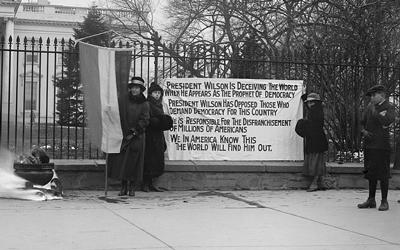
Description
Three suffragettes hold a banner outside the gates of the White House in this 1918 photograph by Harris & Ewing. The banner accuses President Woodrow Wilson of hypocrisy when he claims to fight for and support democracy during World War…
Suffragists at the 1920 Republican National Convention in Chicago, Illinois, June 8-12, 1920
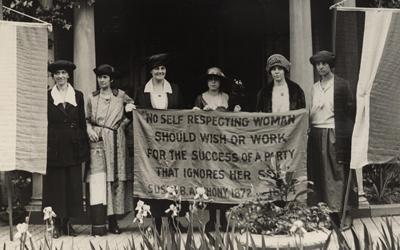
Description
This photograph, taken at the June 1920 Republican National Convention in Chicago, depicts six suffragists (including Alice Paul, second from the right) gathered in front of a building with suffrage banners. One of the banners even includes a quote from the the influential…
"The Sky is Now Her Limit" Political Cartoon, August 1920
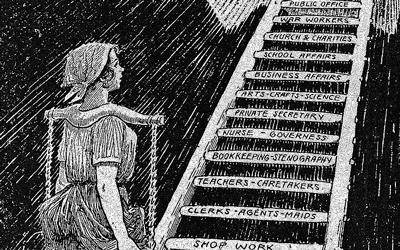
Description
In this 1920 cartoon “The Sky is Now Her Limit,” a young woman carrying buckets on a yoke looks up a ladder ascending up to the sky. Among the many rungs, the bottom three are labeled “Slavery,” “House Drudgery” and “Shop Work” while a few at the top are labeled “…
19th Amendment to the U.S. Constitution, August 26, 1920
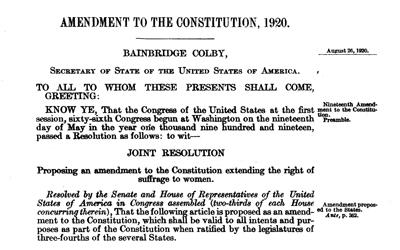
Description
The United States Congress approved a women’s suffrage amendment to the U.S. Constitution and three-fourths of the states ratified it. On August 26, 1920, Secretary of State Bainbridge Colby officially certified the 19th Amendment with his signature and the seal of…
Nellie Tayloe Ross, director of the U.S. Mint, at her farm on Solomon's Island, Maryland, July 29, 1938
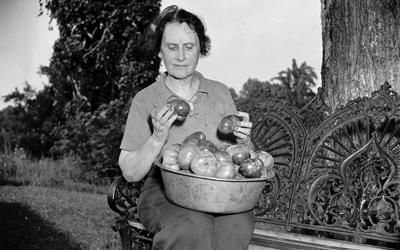
Description
Nellie Tayloe Ross, director of the U.S. Mint, was taken on July 29, 1938, by Harris & Ewing. Ross is shown on her newly-purchased 100-year-old home on a 200-acre farm. She is examining tomatoes on an ornate iron bench while wearing work…
H.Res. 159, "Honoring the New Hampshire State Senate for becoming the 1st statewide legislative body with a majority of women,” November 3, 2009

Description
The United States House of Representatives honored the New Hampshire State Senate on Nov. 2, 2009, for becoming the first statewide legislative body with a majority of women. In this document, the role of women in leadership positions in the New…
Additional Resources:
- Iowa Women's Suffrage Collection
To celebrate the centennial of the 19th Amendment, the State Historical Society of Iowa has shared photographs and documents from the Iowa Women's Suffrage Collection. - "One Hundred Years toward Suffrage: An Overview"
This website provides a timeline from Abigail Adams’ "Remember the Ladies" letter to her husband through the first proposal of the Equal Rights Amendment in 1923. - "Primary Documents in American History: 19th Amendment to the U.S. Constitution"
This web guide provides a wide variety of primary sources gathered from different Library of Congress collections related to the 19th Amendment. - "The Fight For Women’s Suffrage"
An Iowa Public Television online resource that summarizes the history of women’s suffrage in Iowa. - The Suffrage Postcard Project
A database of illustrations and images of masculinity and fatherhood found in anti-suffrage postcards in circulation in the decade prior to ratification of the Nineteenth Amendment. - The National Women’s History Museum
The museum's website provides an impressive amount of educator resources related to the suffrage movement. - The 19th Amendment and the Women's Suffrage Movement
This website provides additional resources about the fight and legacy of the women's suffrage movement.
Iowa Core Social Studies Standards (9-12th Grade)
Listed below are the Iowa Core Social Studies content anchor standards that are best reflected in this source set. The content standards applied to this set are high school-age level and encompass the key disciplines that make up social studies for 9th through 12th grade students.
| No. | Standard Description |
| SS-US.9-12.13. | Analyze how diverse ideologies impacted political and social institutions during eras such as Reconstruction, the Progressive Era, and the Civil Rights movement. |
| SS-US.9-12.14. | Evaluate the impact of gender roles on economic, political, and social life in the U.S. |
| SS-US.9-12.15. | Assess the impact of individuals and reform movements on changes to civil rights and liberties. |
| SS-US.9-12.27. | Evaluate Iowans or groups of Iowans who have influenced U.S. History. |
| SS-Gov.9-12.14. | Analyze the role of citizens in the U.S. political system, with attention to the definition of who is a citizen, expansion of that definition over time, and changes in participation over time. |
| SS-Gov.9-12.19. | Evaluate the effectiveness of political action in changing government and policy, such as voting, debate, contacting officials, campaign contributions, protest, civil disobedience, and any alternative methods to participation. |
| SS-Gov.9-12.24. | Analyze how people use and challenge public policies through formal and informal means. |